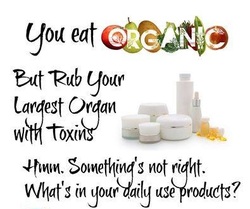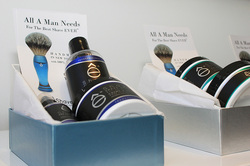
Did you know that the average woman wears approximately 515 chemicals every day?!? Men aren't exempt either. More and more men are using personal care products such as moisturizers and lotions, not to mention deodorant, shampoo, conditioner, and all the other products that we all use regardless of gender.
Is it any wonder the rates of diseases such as cancer, Alzheimer's, and autism have skyrocketed over the past few decades? Now more than ever, it's essential that we take steps to protect our health and take control of what goes into our bodies! Using all-natural products on our skin is a great start, but they can be somewhat difficult to find. Many products marketed as "natural" or even "organic" still contain harmful chemicals. There are a few companies consistently producing healthy and safe personal care products, and we recommend using these instead of their chemical-filled conventional counterparts. Check out our Products page for some recommendations.
Today, I'm giving you a run-down of just a few of the most common chemicals you will want to avoid. Get familiar with these, make a list and carry it in your purse or wallet, and consult it when shopping. Get used to reading labels, and learn to identify "hidden" chemicals that may be harmful to your health. Here are 9 common ingredients to look out for:
You've probably heard of these, as they are one of the most common ingredients that companies often eliminate from their "natural" products. These preservatives are found in many lotions and skincare products, and they have been linked to breast cancer, endocrine disruption, reproductive problems, and birth and developmental defects. A 2011 California study found that when BPA (a type of plastic often used in product containers) was combined with methylparabens, the resulting substance was able to turn healthy cells cancerous, and also rendered the common cancer drug tamoxifen ineffective.
2. Triclosan
This is the active ingredient in most "anti-bacterial" products such as liquid soaps and hand sanitizer. It is actually registered as a pesticide, and is a known endocrine disrupter, also believed to disrupt thyroid function and contribute to liver toxicity.
3. Petrolatum & Petroleum-Based Ingredients
It may sound like common sense not to put relatives of gasoline on your skin, but actually many products - especially makeup and skin creams - contain petroleum-based ingredients. These are known endocrine disruptors and carcinogens. (We'll list a few specific instances of these a little later.)
4. Oxybenzone & Octinoxate
These, and other "active ingredients" in chemically-based sunscreens filter out UV rays - and also disrupt the endocrine system.

This vague-sounding ingredient can be found in just about every kind of product out there, and it may actually be hiding hundreds of chemicals! Companies are allowed to use this word to cover a huge range of chemicals used to add scent to a product (and even "unscented" products usually contain it!), without having to list each individual ingredient. This means you have no way of knowing what's really in it, but more than 75% of "fragrances" contain phthalates, which are known endocrine disruptors, and also linked to birth defects, breast cancer, infertility, liver cancer, diabetes, and obesity. Dr. Philip Landrigin at the Mount Sinai Children's Environmental Health Center also has linked these chemicals to ADHD and autism.
So what's the deal with all these endocrine disruptors?
If you're not familiar with the endocrine system, well, it's kind of a big deal. In fact, it regulates just about all of the processes in your body - from development of the brain and nervous system, to metabolism and blood sugar levels, reproductive organ health and function, thyroid, pituitary, and hormonal processes, adrenal function, and more. Obviously messing this this system is not a good idea! In fact, in a recent report, the UN and the World Health Organization called endocrine disruptors a "global threat." Protect yourself, and avoid these ingredients at all costs!
6. PEG's (Polyethylene Glycol)
These are petroleum byproducts, and the biggest problem with these is the fact that during the manufacturing process, carcinogenic compounds are created which are called 1,4-Dioxanes. 1,4-Dioxane is known as a human carcinogen, especially effecting the liver and kidneys. The European Union has banned products contaminated with this substance. (Note: You will probably never see "1,4-Dioxane" on a product label, as companies are not required to list contaminants in the ingredients list.)
7. Sodium Laurel Sulfate (SLS) & Sodium Laureth Sulfate (SLES)
You may have heard of these, as some natural product companies now list "SLS-Free" on their labels. These are added to things like body wash and shampoo as a sudsing agent. These substances are common skin irritants that are considered carcinogenic, and they also may be contaminated with 1,4-Dioxane.
8. Ingredients That End In "ETH"
If you see "eth" at the end of an ingredient, it may very well contain 1,4-Dioxane. Ceteareth and triceteareth are a couple of examples, but there are many others. Just stay away from "eth" to be safe.
9. Retinyl Palmitate
A 2011 FDA report found that this common skin care ingredient increased incidence of skin cancer lesions by 21% when exposed to sunlight. Ironically enough, this ingredient is most commonly found in moisturizers and sunscreens!
These are just a few chemicals that you should avoid putting on your body, but there are lots more! Be sure to check back next week when we'll give you 9 more ingredients to add to your "avoid" list.
In the meantime, print out this post, or just write down the names of each chemical and carry it with you when shopping for personal care products either for yourself or your loved ones this holiday season. After all, it is the season of gift-giving, and what's a better gift than health?
For an excellent line of safe and 100% natural personal care products for men, women, children, and even pets, check out Ava Anderson products. (Use "Party Code": 42532 when ordering.)
Happy - and healthy - shopping!
Rose.



 RSS Feed
RSS Feed